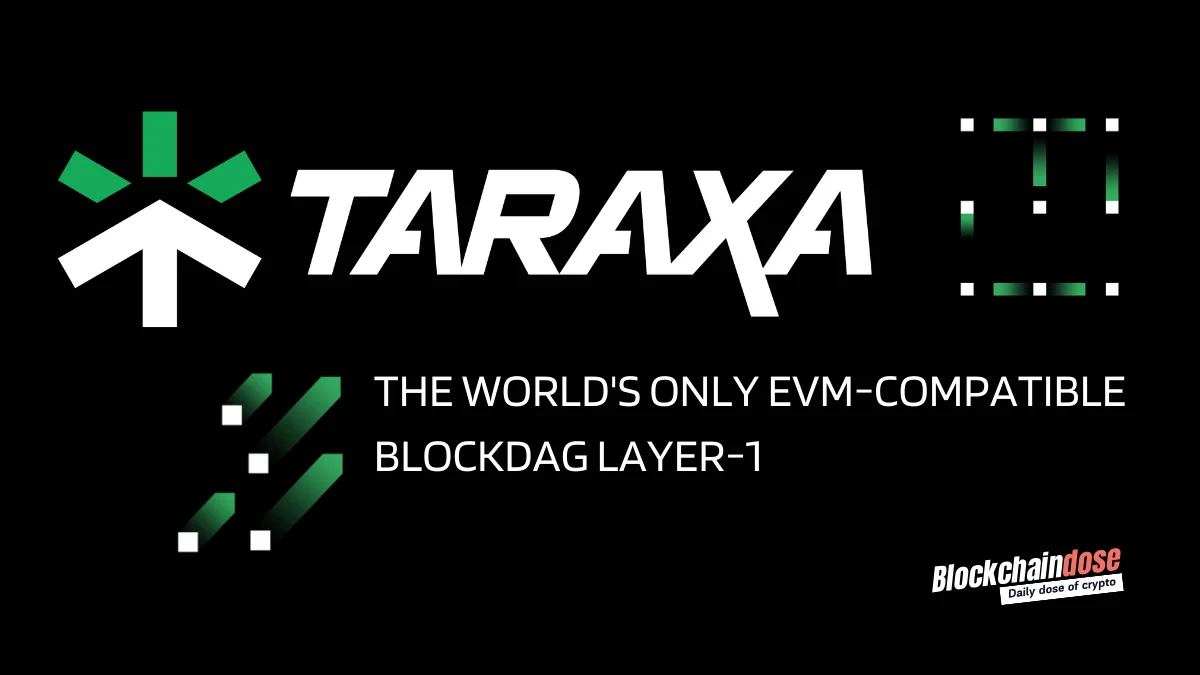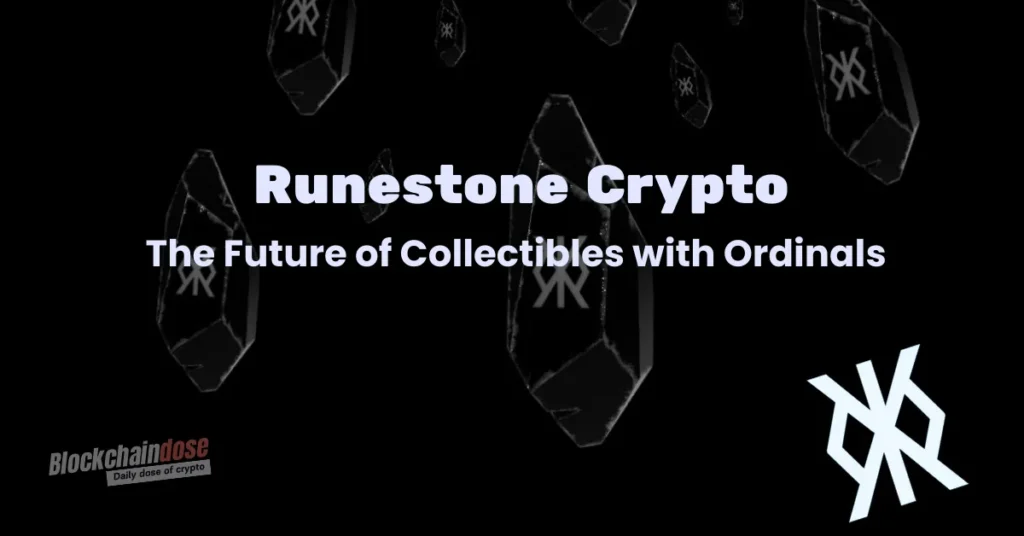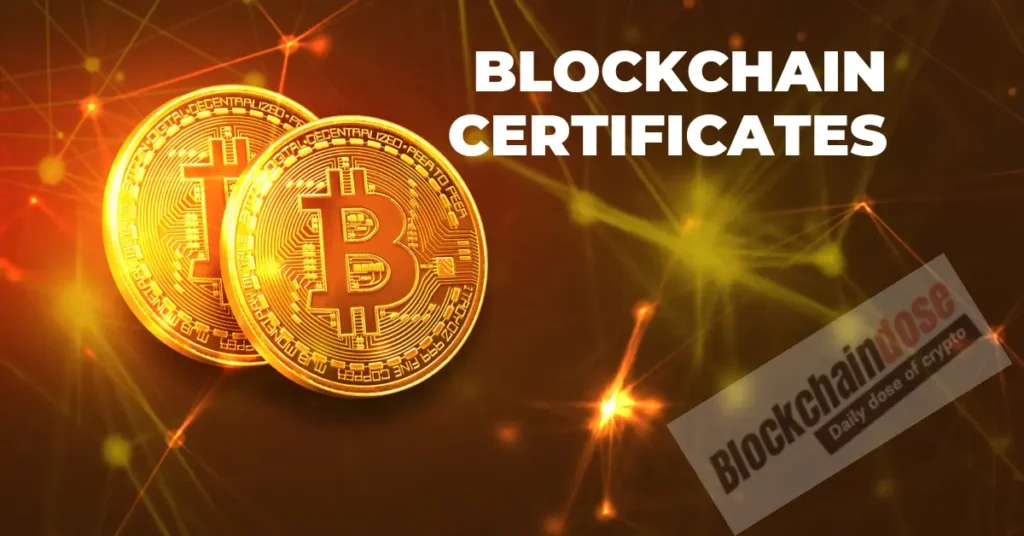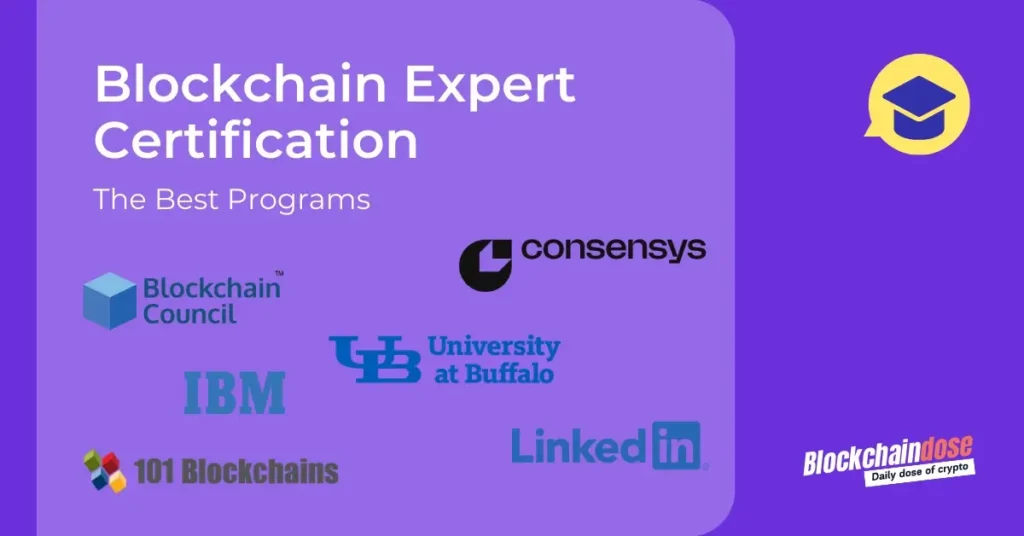Taraxa is a cutting-edge blockchain network designed to elevate businesses’ credibility and reputation. This network achieves this massive feat by ensuring the integrity of informal transactional data.
Informal transaction data includes records of trades or transactions not featured within the structured systems of legal documents and hence not verifiable. Taraxa takes the reins by simply auditing and scrutinizing all informal transactions. The result is an adequate provision of tools necessary to make better business decisions.
Key Takeaways
- Taraxa boosts business credibility through blockchain.
- It verifies informal transactions not covered by legal documents.
- Businesses gain better decision-making tools with reliable data.
Bringing Trust to the Unseen Side of Business
Here’s the thing—well-established entities, brands, and corporations already enjoy a strong reputation and hence earn trust easily. Yet, their smaller counterparts and businesses find it extremely hard to prove their credibility to others.
And the reality of matters is that larger corporations dismiss informal transactional data, which is the primary type of data in smaller businesses. This is essential because it does not have any firsthand validation and verification by stakeholders.
That’s where Taraxa comes in—this blockchain aims to level the playing field by simply granting all entities, large or small, verifiable transactions.
Taraxa’s primary mission is democratizing entities’ reputations by simply tracking informal transactions. Once they verify the informal transactions, even small, more minute participants can enjoy a stronger reputation in the market.
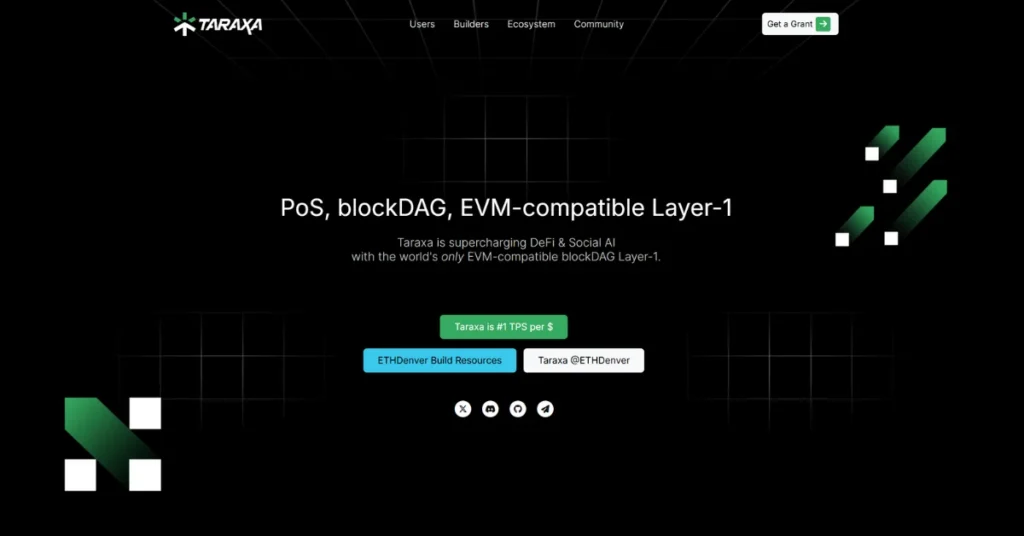
Taraxa: The BlockDAG Consensus Mechanism
At the heart of the Taraxa Network is a Consensus mechanism, BlockDAG (Directed Acyclic Graph), which eliminates the bottlenecks of scalability in the blockchain. This network’s consensus enables parallel transaction processing, effectively boosting transaction throughput.
Taraxa takes a different approach. It combines standard PoS with a unique BlockDAG structure, allowing parallel block creation without relying on a fixed set of delegates. To tackle challenges like randomness, ordering, and block efficiency—issues DPoS typically addresses—Taraxa is developing innovations like Fuzzy Sharding. This preserves decentralization while improving performance, without the need for centralized validator selection.
Compared to more traditional consensus mechanisms, Taraxa’s BlockDAG forms a web-like structure, referencing multiple previous blocks. This boosts consensus efficiency and improves the network’s general resilience.
Furthermore, Taraxa embedded an Anchor Chain mechanism designed to ensure that all nodes always align on one common transaction history. This not only prevents conflicts but also reduces the opportunities for forks.
Taraxa does not compromise on security when building its system. Through the philosophy of Practical Byzantine Fault Tolerance, the Taraxa BlockDAG achieves transaction finality while ensuring everything becomes irreversible in a predictable timeframe.
Features of Taraxa Blockchain
Lightning-fast Transactions
Blistering transaction speed is a standout feature of the Taraxa blockchain. Everyone admires fast transaction processing for their activities, and Taraxa provides just that.
The network claims to be capable of processing about 5K transactions per second at the time of writing, with the finality reached in about 3.7s. These transactions are instantly added to blocks with sub-second dynamic block rates.
The Taraxa blockchain network is still working hard to reach 50k transactions per second. While some platforms compromise on decentralization and security to boost speed, Taraxa doesn’t. Taraxa blockchain security is seen as high.
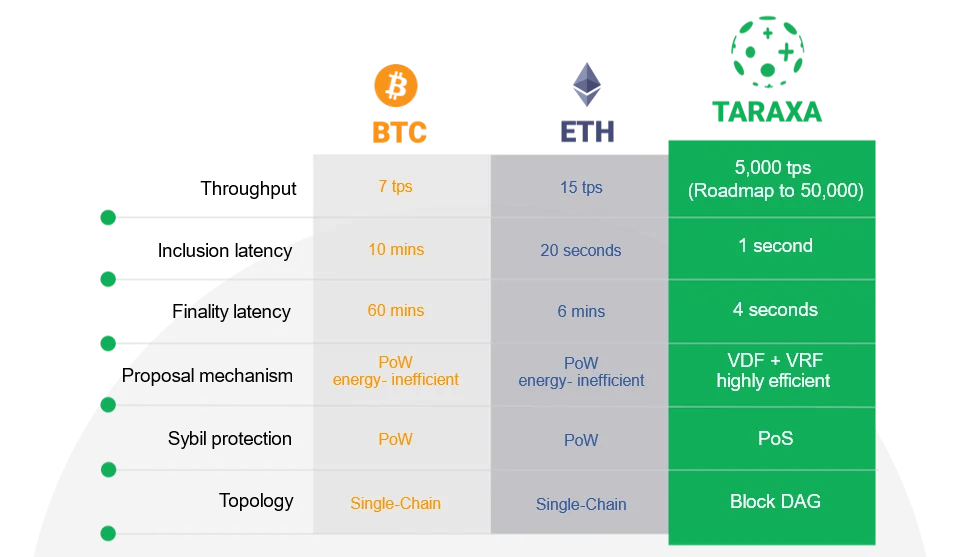
Seamless EVM Compatibility
Another strong feature of the Taraxa blockchain is EVM compatibility. Taraxa blockchain generally offers compatibility with the Ethereum Virtual Machine for app creators.
Let’s say you are a highly conversant developer with the Ethereum blockchain network. If you want to work with other non-EVM chains like Solana, you must learn and change how you do things.
However, everything remains the same on Taraxa. You do not need to relearn. All dApps, frameworks, and toolchains functioning with the EV will work on Taraxa. Hence, you need not to learn new things.
Moreover, the Taraxa blockchain has 100% native EVM integration, meaning it offers speed and security similar to those of Ethereum.
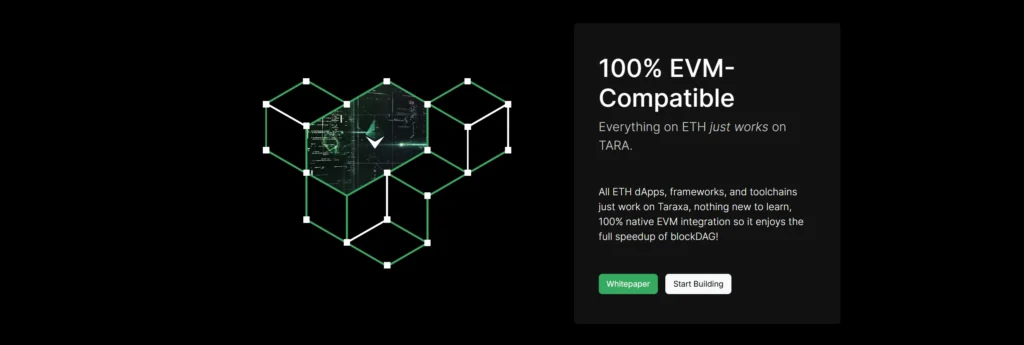
Lowest Cost
The third benefit associated with the Taraxa blockchain network is low costs. This network boasts of demanding the weakest fees and hardware requirements of all blockchains worldwide. By reducing the costs associated with the network, Taraxa generally enjoys higher decentralization than most Layer 1 and Layer 2 networks.
Taraxa Blockchain: The Taraxa Coin (TARA)
Deep within the Taraxa Blockchain network is the native token known as $TARA. This is the primary currency of the entire network, providing a range of utilities, including:
- Gas fee settlement: The TARA tokens’ primary function within the Taraxa blockchain ecosystem is to settle gas charges. The gas charges are imposed when executing smart contracts and recording blockchain transactions.
- Tara staking: Tara token holders can also stake these tokens and participate in securing the whole blockchain. Securing the chain involves validating the transactions and earning rewards as a result.
- Medium of exchange: TARA is the currency of Taraxa blockchain. You can use the tokens to conduct business transactions and peer-to-peer transfers. It is also available on crypto exchanges for traders
- Governance: Holders of the TARA token earn a chance to vote in future project decisions.
Taraxa Blockchain: The Roadmap
The project has been in development since around 2018. According to their roadmap, two Stanford engineers collaborated in 2018 to begin this network, choosing blockDAG, PoS, and EVM as the primary features.
Between 2019 and 2022, the Taraxa testnet was launched, and the L1 audits were completed in the same period. During this period, Taraxa built a social AI platform named Echo and focused on developing real-world use cases.
The Taraxa mainnet was launched in 2023 and later upgraded through the Magnolia upgrade. During this same period, the first Dapps on Taraxa’s social AI platform were developed.
In 2024, the Taraxa network introduced and capped the supply of TARA tokens. In this same year, a $10 million grant program was launched. A DeFi ecosystem and a visualizer were also launched in 2024.
Looking ahead to 2025, the Taraxa network already has its roadmap for the year set up with ambitious developments in line:
- First Half of 2025: Completing liquid staking, account abstraction, fiat on-ramps, and performance benchmarking.
- Second Half of 2025: Post-quantum VM integration and further optimization and benchmarking.
How to buy Taraxa?
The process of purchasing TARA tokens is very short and involves a few steps. These include:
Find a Crypto Exchange Platform
Many crypto exchange networks, such as KuCoin, CoinEx, MEXC, and Gate.io, have already listed the TARA coin for sale. Your first task is researching all those exchanges to spot one with a good reputation and favorable features.
After choosing the exchange, register. Here, you simply provide all the necessary information and details, including your email address. Furthermore, you must secure your new exchange account with a strong password and possibly 2FA.
Complete the needed identity verification. Most centralized exchanges will demand a verification of identity and country of residence.
Fund your exchange account
Deposit some crypto in your centralized crypto exchange wallet to begin the purchase. If you do not have crypto, you can use fiat currency payment methods like bank deposits, credit/debit cards, or third-party payment channels to purchase crypto like ETH, BNB, BTC, or USDT. You can then exchange any crypto you purchased for TARA on centralized exchanges.
Buy Taraxa (TARA):
Depending on the crypto exchange you have chosen to use, go to the ‘Buy and Sell’ section. Search for TARA. Follow the Necessary steps to purchase.
Store TARA in Another Wallet
Keeping your crypto on exchange wallets is never a good idea. It exposes your account to many security and financial risks. The better option would be transferring the assets to a personal wallet, mostly hardware wallets like Trezor and Ledger. However, other Web3 wallets like Metamask and Trust have been proven to have strong security.
Final Words
Our guide took a keen dive into the world of the Taraxa blockchain, uncovering its primary functions and features. The Taraxa blockchain creates a superfast, 100% EVM-compatible, and low-cost ecosystem for everyone.
Native to Taraxa is the coin TARA, which boasts high potential owing to its wide range of utilities within the ecosystem. This guide has also explored the steps to follow to buy coins in the markets easily and benefit from the next bull run.
